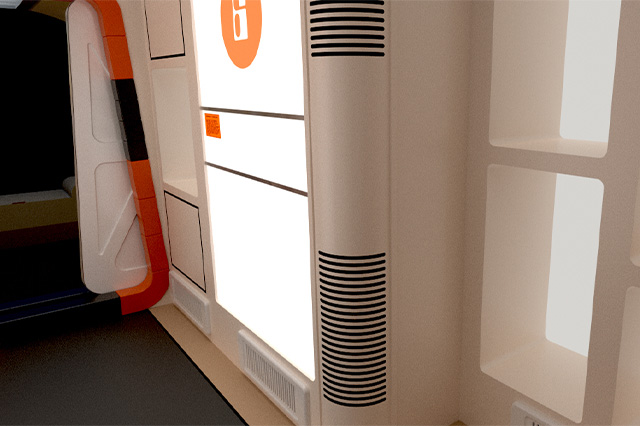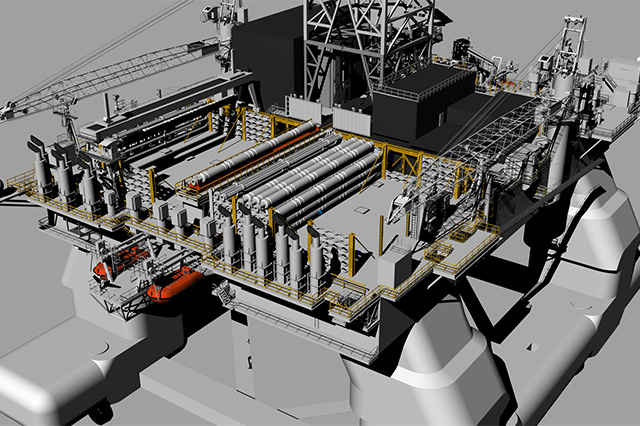
Q&A with Tim Earls, Set Designer Behind the Recreation of the Eagle Spaceship
Q&A with Tim Earls, Set Designer Behind the Recreation of the Eagle Spaceship
Tim Earls, a multi-faceted set designer, artist and illustrator known for his contributions to films like Star Trek: Voyager and Babylon 5, has helped create iconic spaceships – such as the Firefly Class and the Warlock Class Destroyer – as well as instantly recognizable spaces such as Tony Stark’s garage in Iron Man 3 and Mars Dome in Babylon 5.
Most recently, Earls designed the life-size Eagle replica to be built for The Eagle Obsession documentary, and we caught up with him for a brief Q&A to hear more about his career and artistic apporach.
Q: Can you take us through your creative process when you were tasked with designing the Eagle spaceship recreation from Space: 1999? What were the key considerations and challenges you faced during the design phase?
I did a lot of research, trying to find screengrabs, blueprints – which don’t exist – trying to get it as accurate as possible. And then after I tried to figure out what all the dimensions were, I started doing 2D plans of each of the sections. I built it starting from the front to the back, from the cockpit to the intermediate section, and then the passenger module.
I put a lot of work and detail into the cockpit, which you can’t really see in the renders. I originally started in a 2D program, doing the straight-on elevations and plans, and then I built it up from there in my 3D modeling program.
It was kind of a push and pull, because I had to go back to the photographs to go, “Hm, that kind of doesn’t look right…” That went on for several weeks. Then I did some texture maps and created the renders.





Q: With your background in architecture and extensive experience as a set and concept designer, how did your architectural training influence your approach to designing the spaceship?
I have 14 years of experience in architectural design, and I was kind of a frustrated engineer. I wanted to get an engineering degree in aerospace, but I ended up getting it in fine arts.
The script is usually the first thing we set designers get, and on projects like Babylon Five and Star Trek, I would read the script and make little scribbles and 3D sketches in the notes. For example, when I was on Serenity, which was the spinoff movie from Firefly, I was the only person hired from the original series. So I got to redesign all the sets for the big screen, which took lots of attention to detail.
Q: Given your impressive professional journey working on the sets of sci-fi films, it’s safe to say you’re interested in the genre. When did that begin?
I’ve been drawn to the sci-fi genre since I was about 5 or 6 years old. I got really interested in the space program at the time, and when I was about 10, I found the phone number to the Kennedy Space Center. I called them up while my parents were at work. Then a couple weeks later, the phone bill came (laughs).
I used to do a lot of spaceships – I did the Enterprise. Then, fortunately I got my first job in the film industry as a set designer for Babylon Five. They started asking me to do concept drawings for ships, and at the end of the first year, they bumped me up to Art Director of Visual Effects. So I did a lot of ships for that show.
When that series ended, I got hired by Star Trek and did a lot of sets and spaceships for them, too. Then I got hired for the pilot of Firefly and helped designed the ship.
I’m drawn to the sci-fi genre because there are a lot of ideas involving things that could happen, and I’m always interested in possibilities and new designs and new ways of accomplishing things. I just enjoy it.





Q: Space: 1999 has a dedicated fan base. Are you a fan of the show yourself, and if so how did that impact your design choices for the Eagle spaceship?
Yeah, I watched it as a kid. Designing the Eagle was just a fun thing for me – it was something I’d always wanted to do. When the show came out, there was a model kit, so of course I bought that. The show was a Gerry Anderson production, and I’d been watching his stuff since Thunderbird. So, naturally, I was a fan when Space:1999 aired.
I used to get the Starlog magazine, and one day the Eagle blueprint showed up in of of the issues. I thought that was pretty cool, and then years later when I was working on Voyageur, our graphic designer left and Geoffrey Mandel showed up. He was the one who did the blueprints in the magazine. He just re-did those blueprints and is selling them now.
A few years ago, they came out with the 22” model of the Eagle. So I’ve got a couple of those, but I haven’t put them together yet.
Q: The Eagle spaceship has become an iconic part of Space: 1999. Did you make any changes to it in your design?
There are a few things about the Eagle that I just slightly changed when I was designing the model, which made it look a little more realistic. I tried to stay true to the original from the show, but I kind of fudged things back and forth to make it look a little better.